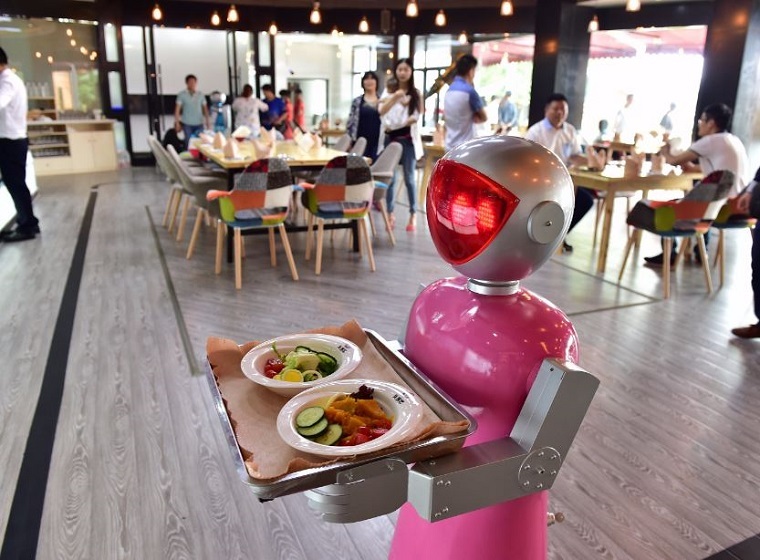Today, 57% of consumers agree that technology in restaurants improves their guest experience. And while we’ve already seen the introduction of apps and bots from restaurant chains, this only marks the start of how technology might further impact the hospitality industry in years to come.
Of course, it might not be such a smooth transition. Oracle’s Restaurant 2025 report suggests that consumers could find some tech a step too far, with 40% saying that being served by a robotic machine would feel invasive or strange.
With this in mind, here’s a run down of a few examples of innovative restaurant technology that has already arrived, as well as how it could evolve in future.
Voice for payments and billing
According to Barclaycard, 37% of diners prioritise quick service in restaurants over menu or value for money, meaning that convenient payment options are becoming increasingly popular.
With many restaurants introducing apps that allow customers to order and pay without the need for a waiter, this demand is being met.
Take Wetherspoons’ Order and Pay. This is a particularly interesting example, however, as it changes more than just the payment experience. Taking away the need for any social interaction at all, some have suggested it spells the end of traditional pub culture. A rather dramatic view, perhaps, especially when you consider how many other well-known chains, like Wahaca and Jamie’s Italian, are using similar technology.
Meanwhile, other London restaurants like Rum Kitchen and Salt Yard are also incorporating bill-splitting apps, making payment even easier for big groups.
Click here to download our Order & Pay app, available for iPhone and Android#OrderAndPayhttps://t.co/sN3tSWoS6s
— J D Wetherspoon (@jdwtweet) March 15, 2017
So how will this develop in future?
Restaurant Business says that voice could be the next step, reporting that several San Francisco-based eateries are already experimenting with a Google-supported system involving voice and facial recognition. Instead of asking for the bill and manually paying, all diners will need to say is “I’ll pay with Google” before being automatically charged.
With suggestions that Starbucks and McDonalds are also introducing voice recognition into their apps in 2017, it could be here before you can say ‘happy meal’.
Staff using wearable technology
While smartwatches are most commonly used by consumers to track diet and fitness, we could see more restaurants utilising wearable tech in order to facilitate better customer service.
Recently, Danny Meyer, the founder of Shake Shack, announced a partnership with Apple Watch that will integrate the technology into front-of-house service in a New York restaurant. Managers and sommeliers will constantly be alerted and informed via the watch, with information being sent about VIP guests, menu changes and complaints.
In future, Oracle suggests that we could also see this technology infiltrating kitchens, with the Internet of Things enabling staff to ‘talk’ to appliances while they work.

Robot service
Robots taking over the world was once the storyline for every mediocre sci-fi movie, but it could now be the reality for the modern service industry at the very least.
Self-service machines have overtaken humans in many restaurant chains, however this could also extend to the preparation and creation of food itself.
Last year, Momentum Machines – a tech startup behind a fully autonomous burger-making machine – applied for a permit, indicating that it is to open a robot-only restaurant. While it’s hard to find any details on its progress or even if it’s going ahead, this example shows that robots have the potential to replace both servers and chefs.
With the prediction that 50% of jobs could be at risk from robots, it could also be a scary glimpse into the future.
Virtual reality experiences
Lastly, while the likes of Heston Blumenthal has been experimenting with dining as a sensory experience for years, it’s now going beyond what’s on the actual plate, with virtual reality being used to transport diners to another place entirely.
Samsung is one of the first tech brands to get on board, rolling out its Gear VR glasses to restaurants that want to create more than just a bog-standard meal.
Even more mind-bending is Project Nourished, a New York-based tech company which builds solutions for ‘fine dining without concern for caloric intake or other health-related issue’. In other words, it uses tech to trick us into thinking we’re eating foods we’re not.
It’s as bonkers as it sounds. But what’s even crazier is that we can do this, yet we can’t make aeroplane food taste nice.



Comments